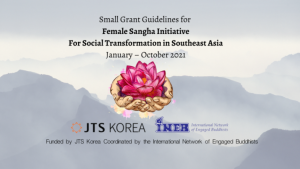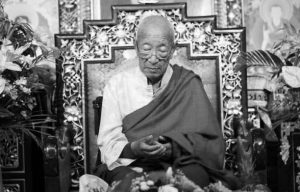
The Two Paths in Pure Land Buddhism
Practitioners who have studied the Shandao tradition of pristine Pure Land Buddhism will in all probability possess an extensive knowledge of the Pure Land teachings. According to these teachings, there are two paths leading to rebirth in Amitabha’s Land of Bliss: the Path of Importance and the Path of the Great Vow.
The Path of Importance comprises miscellaneous or mixed meditative and non-meditative practices characterized by self-power; thus, dedication and aspiration for rebirth in the Land of Bliss are necessary if one wants to be reborn there. This is the path to the Pure Land according to the teachings of the Buddha Shakyamuni, the Transformation Buddha in our Saha World, which is a conditioned realm of reincarnation. The Path of the Great Vow, on the other hand, consists of the exclusive practice of Amitabha-recitation characterized by other-power, with Amitabha’s Fundamental Vow as an augmentative cause for rebirth; thus, dedication and aspiration are unnecessary if one wishes to be reborn in the Land of Bliss. This is the path to the Pure Land according to the teachings of Amitabha Buddha, the Reward Buddha in the Land of Bliss, which is an unconditioned realm of nirvana.
Different Causes and Different Practices for Rebirth
Nevertheless, all Buddhists know of Amitabha Buddha and his Land of Bliss through the golden words spoken by the Buddha Shakyamuni, because ordinary beings like ourselves are unable to visualize the splendid form of the Reward Buddha and his Reward Land adorned by his merits and virtues. Therefore, as most Pure Land practitioners commence their Buddhist practice with assorted meditative and non-meditative virtues characterized by self-power, most of them will seek rebirth according to the Path of Importance when they initially convert to Pure Land Buddhism.
The details of this path are fully described in the contemplation of the Three Tiers and Nine Levels of Rebirth (described in the 14th, 15th, and 16th contemplations) in the Contemplation Sutra. Master Shandao said that practitioners of the non-meditative virtues in the Three Tiers take the Three Meritorious Deeds* as the main cause and thus the Nine Levels of Rebirth as the main practice. This path is also applicable to those who take the meditative virtues as the main cause and different levels of contemplation (stipulated in the 1st to 13th contemplations) as the main practice.
By contrast, Pure Land practitioners on the Path of the Great Vow take the Three States of Mind** in the Contemplation Sutra as the main cause and Amitabha-recitation as the main practice. Obviously, the Path of the Great Vow is easier to practice because only one practice is required; however, it is difficult to trust in it. Although it is difficult to practice because assorted and mixed practices are required, it is easier to trust in the Path of Importance.
Questions Arising during the Transition from Mixed Practice to Exclusive Practice
When Pure Land practitioners have the causal conditions to hear Master Shandao’s teachings and gain an extensive knowledge of Pure Land Buddhism, some may prefer to take the easier path of the Path of the Great Vow for rebirth in the Land of Bliss. Knowing that single-minded and exclusive practice of Amitabha-recitation will ensure their rebirth in the Land of Bliss, they then have to transition from a miscellaneous/assorted/mixed practice to one of exclusive Amitabha-recitation.
However, during the transition from mixed practice to exclusive practice, many Pure Land practitioners find that certain questions arise, such as:
– How can we do nothing but practice exclusive Amitabha-recitation day and night, single-mindedly? Should we give up everything except the recitation of Amitabha Buddha’s name and just wait to die? We have to live, study, and work, so we cannot practice it without interruption.
– I have volunteered at a temple for many years. If I continue to go there, is it regarded as “mixed practice”? I have many Buddhist friends there. Can I still spend time with them?
– I know I should focus on Amitabha-recitation and no longer do meditative and non-meditative virtuous practices. However, I used to recite the name of Avalokiteshvara as well as his dharani or mantra, which I enjoyed. Can I continue to recite these?
– I know that the Three Meritorious Deeds are practices related to the Path of Importance, which is only an indirect way to be reborn in the Land of Bliss. However, should I continue to follow some of the guidelines, such as filial piety and being good to others, even though they are not prerequisites for direct and assured rebirth?
Such questions are never-ending.
Duty and Responsibility versus Practice for Gaining Rebirth
As people of different capacities encounter different karmic circumstances in their lives, they can in fact be classified into more than Three Tiers or Nine Levels, or even ten thousand grades, in such a world of assorted births as our Saha World. However, if they can be single-minded in dedicating all the merits and virtues of their past lives and aspire to be reborn along the Path of the Great Vow, they are assured of rebirth by Amitabha Buddha, with his Fundamental Vow as an augmentative cause.
In this respect, we need not make many changes in our daily lives during the transition period; we can just do whatever we usually do. Nevertheless, we must be mindful of the following: as ordinary Buddhists, we should, as a matter of course and of duty and responsibility, undertake the various virtuous practices taught by the Buddha Shakyamuni. We should practice according to our personal capacity, preferences, and karmic circumstances, until we are received by Amitabha Buddha as we are about die. If we attend religious services connected with other practices or other Buddhas, we can dedicate the merit solely for rebirth in the Land of Bliss. Sooner or later, our attitude towards these “virtuous practices” will change of its own accord. We will carry out these activities through a sense of duty and responsibility, but not in order to attain rebirth in the Land of Bliss.
For the purpose of gaining rebirth in the Pure Land, it is clear and definite that recitation of Amitabha’s name should be our sole practice. We develop trust in it as the most direct and easiest route for assured rebirth in the Land of Bliss because it accords with Amitabha’s Fundamental Vow, and also because of the admonition of the Pure Land lineage masters, from Nagarjuna and Shandao on down.
In my next article, I will discuss some examples from daily life to illustrate the difference between mixed practice and exclusive practice.
* First: caring for one’s parents, attending to one’s teachers and elders, compassionately refraining from killing, and performing the ten good deeds; second, taking the Three Refuges, keeping the various precepts, and refraining from breaking the rules of conduct; third: giving rise to the aspiration for Enlightenment, being convinced about the law of causality, and chanting the Mahayana sutras and encouraging people to follow their teachings. (Based on a translation from the Chinese by Hisao Inagaki)
** The Sincere Mind, the Deep Mind, and the Merit-dedication and Aspiration Mind.






